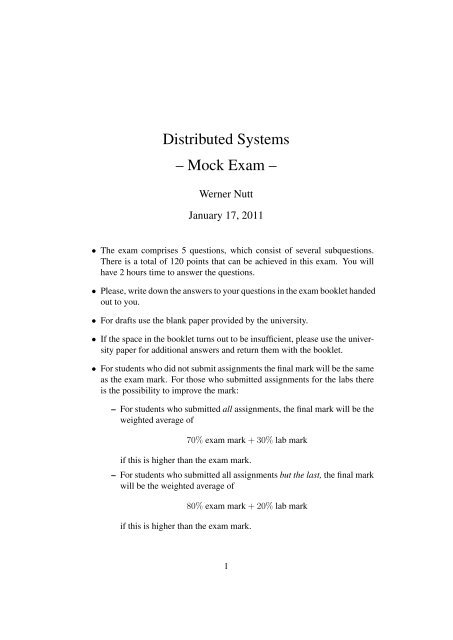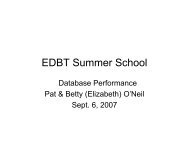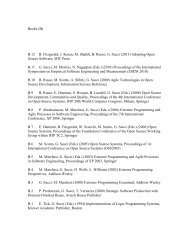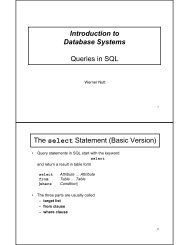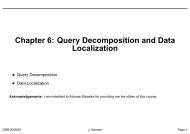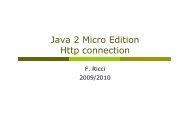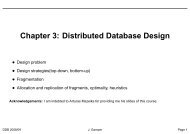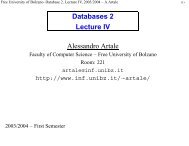Distributed Systems â Mock Exam â
Distributed Systems â Mock Exam â
Distributed Systems â Mock Exam â
Create successful ePaper yourself
Turn your PDF publications into a flip-book with our unique Google optimized e-Paper software.
<strong>Distributed</strong> <strong>Systems</strong><br />
– <strong>Mock</strong> <strong>Exam</strong> –<br />
Werner Nutt<br />
January 17, 2011<br />
• The exam comprises 5 questions, which consist of several subquestions.<br />
There is a total of 120 points that can be achieved in this exam. You will<br />
have 2 hours time to answer the questions.<br />
• Please, write down the answers to your questions in the exam booklet handed<br />
out to you.<br />
• For drafts use the blank paper provided by the university.<br />
• If the space in the booklet turns out to be insufficient, please use the university<br />
paper for additional answers and return them with the booklet.<br />
• For students who did not submit assignments the final mark will be the same<br />
as the exam mark. For those who submitted assignments for the labs there<br />
is the possibility to improve the mark:<br />
– For students who submitted all assignments, the final mark will be the<br />
weighted average of<br />
70% exam mark + 30% lab mark<br />
if this is higher than the exam mark.<br />
– For students who submitted all assignments but the last, the final mark<br />
will be the weighted average of<br />
80% exam mark + 20% lab mark<br />
if this is higher than the exam mark.<br />
1
1 Protocols<br />
(i) If you had to implement a protocol for remote method invocation, on which<br />
transport level protocol would you base it, UDP or TCP? Explain your answer.<br />
(5 points)<br />
(ii) Suppose you have to implement a request-reply protocol. For each of the<br />
three, UDP, TCP, and HTTP, discuss whether one could use it as the basis<br />
for the new implementation. Which one would be the most suitable and<br />
which one the least? Why?<br />
(15 points)<br />
2 Java RMI<br />
Suppose a server is to be implemented for a book shop where customers can place<br />
orders and managers can check how many copies of each book have been ordered.<br />
There are two methods to access the server,<br />
1. order, which takes four strings, name, cardNo, bookCode, and address<br />
as arguments, and stores that the customer with that name and the credit<br />
card number cardNo has ordered a copy of the book identified by bookCode<br />
to be sent to address;<br />
2. copiesOrdered, which takes a string bookCode as argument and returns<br />
an integer, representing the number of copies ordered of the book with<br />
code bookCode<br />
(i) Write down the declarations of the interfaces and the classes (including the<br />
method declarations) that have to be implemented on the server side.<br />
(12 points)<br />
(ii) Describe how you would implement a small client program that can be<br />
started from a command shell, with the book code as argument, and returns<br />
the number of copies that have been ordered.<br />
(8 points)<br />
(iii) Which compilation steps have to be made in which order before the client<br />
can be started?<br />
2<br />
(4 points)
3 Lamport’s Logical Clocks<br />
Consider three distributed processes P 1 , P 2 , and P 3 . The processes are involved in<br />
the events a, b, . . . , k listed below, which happen at spefic points in time, specified<br />
as “wall-clock time” (WCT) and measured in ms:<br />
At 0ms WCT:<br />
a: P 2 sends message m 1 to P 1<br />
b: P 3 reads a startup file<br />
At 100ms WCT:<br />
c: P 1 opens a file containing a user profile<br />
d: P 3 sends message m 2 to P 2<br />
At 200ms WCT:<br />
e: P 1 receives message m 1<br />
f: P 2 receives message m 2<br />
At 300ms WCT:<br />
g: P 1 sends message m 3 to P 2 and P 3<br />
At 400ms WCT:<br />
h: P 2 receives message m 3<br />
At 500ms WCT:<br />
i: P 2 sends message m 4 to P 1<br />
At 600ms WCT:<br />
j: P 1 receives message m 4<br />
At 600ms WCT:<br />
k: P 3 receives message m 3<br />
(i) Which of these events are related by Lamport’s “happened before” relation<br />
(in the lecture denoted as “E 1 → E 2 ” if event E 1 happened before<br />
event E 2 )? Draw a directed graph where the events are vertices and where<br />
there is an edge from E 1 to E 2 if E 1 happened before E 2 .<br />
(10 points)<br />
(ii) Associate to each event a logical timestamp according to the logical clock<br />
algorithm. What is the linear order of events induced by these timestamps?<br />
(10 points)<br />
3
4 Invocation Semantics<br />
Three different semantics have been defined for remote method invocation, “maybe”,<br />
“at-least-once”, and “at-most-once” semantics.<br />
(i) Briefly explain what each of the three means.<br />
(6 points)<br />
(ii) How can one implement at-most-once semantics? Which are the problems<br />
that need to be addressed?<br />
(5 points)<br />
In the context of invocation semantics, on distinguishes between idempotent and<br />
non-idempotent invocations.<br />
(iii) When is a method invocation idempotent? Give an example of an invocation<br />
that is idempotent and of one that is not!<br />
(4 points)<br />
(iv) How can the implementation of at-most-once semantics be simplified if the<br />
methods invoked are idempotent?<br />
(3 points)<br />
As part of the implementation of at-most-once semantics, a site executing remote<br />
method invocations will store results of previous invocations.<br />
(v) When is the earliest point in time that such a stored result can be safely<br />
removed? Explain your answer.<br />
(3 points)<br />
On some networks it may happen that an earlier message be a sender to a recipient<br />
is overtaken by a later message of the same sender to the same recipient. For this<br />
reason it may be the case that a message with a method invocation is overtaken by<br />
another message with the same method invocation.<br />
(vi) How can one extend the basic implementation of at-most-once semantics so<br />
that no reply needs to be sent out for an invocation message that has been<br />
overtaken by another invocation message?<br />
(5 points)<br />
4
5 Mutual Exclusion<br />
<strong>Distributed</strong> algorithms for solving coordination problems are required to have the<br />
properties of safeness and liveness.<br />
(i) Briefly explain each of the two properties. What does it mean for a leader<br />
election algorithm to have these properties?<br />
(8 points)<br />
In addition to leader election, organising exclusive access to shared resources is<br />
another problem requiring distributed coordination. This problem is often specified<br />
as the problem of Mutual Exclusion.<br />
(ii) Briefly explain what is the problem of mutual exclusion.<br />
(4 points)<br />
A classical solution to mutual exclusion uses a central server and tokens, which<br />
can be requested by clients.<br />
(iii) Briefly explain how the basic algorithm for that approach works.<br />
(4 points)<br />
In addition to the two properties of safeness and liveness, an algorithm for mutual<br />
exclusion is sometimes required to have the ordering property.<br />
(iv) Briefly explain what it means for a mutual exclusion algorithm to guarantee<br />
ordering.<br />
(3 points)<br />
(v) Does the algorithm you described above guarantee safeness, liveness, and<br />
ordering? Give a brief explanation.<br />
(9 points)<br />
The basic algorithm cannot deal with failure. Suppose that clients may fail, but<br />
the central server cannot fail. Moreover, suppose the central server uses a failure<br />
detection service that eventually detects any failed client.<br />
(vi) What would be a simple modification of the central server algorithm so that<br />
it can handle the crash of a client?<br />
(4 points)<br />
5
Suppose that the error detection algorithm is sometimes wrong in its judgement,<br />
that is, it may assume a client has crashed although the client is still working.<br />
(vii) How may the server detect that a client thought to have crashed is still working?<br />
(3 points)<br />
(viii) How can the algorithm be extended so that it is able to deal also with situations<br />
where a client is falsely thought to have crashed?<br />
(5 points)<br />
6


